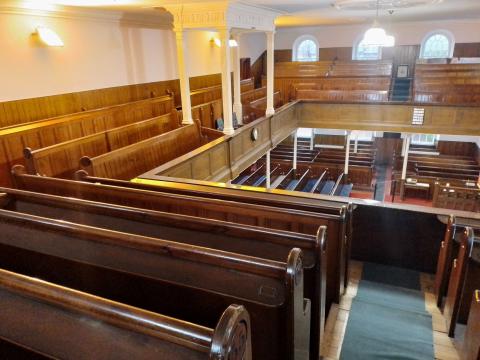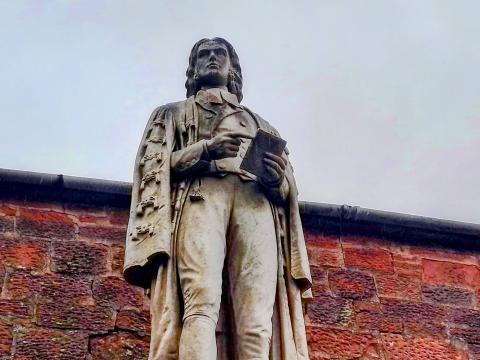Annan's Kirk & Irving's Quirk

KP and I drove to Dumfries in southern Scotland this autumn to see the old Kirk of Annan. We were peering through a window when a lady in the carpark bade us go into the parish hall and seek the minister who kindly admitted us to the building. It would be grand and imposing enough to warrant a piece for its own sake, but this was the kirk in which worshipped a young Edward Irving, one of the more curious characters of nineteenth-century British church history. He helped found the Catholic Apostolic Church in England, which emphasised the immanency of Christ’s return, the restoration of the gifts of the Holy Spirit, such as tongues and prophecy, and the reinstitution of the apostolic and prophetic offices. These issues moved to the fore of evangelical debate in the twentieth century, and Irving has been considered the father of the charismatic movement, as well as heralding the reinstatement of premillennial eschatology, which men like Darby and Schofield would make mainstream by the century’s end.

These doctrines and some other, peculiar beliefs about the Lord Jesus’ human nature, drew the ire of the Scottish Kirk, which determined to rid itself of this maverick, but brilliant, minister. The local presbytery of his native Annan therefore held an ecclesiastical assize in March, 1833, before a packed house in the town's kirk, during which Irving's ministerial credentials and orthodoxy stood trial. He was duly expelled.

Irving died in his 43rd year, as a controversial and divisive figure. His denomination suffered after 1901, when its last apostle, Francis Woodhouse, died, so no new ministers could be ordained. Its remaining assets and affairs were, and continue to be, administered by trustees. In its heyday, the movement was dynamic and lively, attracting such august figures as Thomas Carlyle to its membership, but now it is just a rump, a skeleton of a former self. Like its founder, it was once glamorous and daring, but soon degenerated into deserved obscurity and eventual oblivion. British Prime Minister George Canning went to hear Irving preach, and reported thus:
"His commanding stature, the symmetry of his form, the dark and melancholy beauty of his countenance, rather rendered piquant than impaired by an obliquity of vision, produced an imposing impression even before his deep and powerful voice had given utterance to its melodious thunders; and harsh and superficial half-truths enunciated with surpassing ease and grace of gesture, and not only with an air of absolute conviction but also with the authority of a prophetic messenger, in tones whose magical fascination was inspired by an earnestness beyond all imitation of art, acquired a plausibility and importance which, at least while the orator spoke, made his audience entirely forgetful of their preconceived objections against them. The subject-matter of his orations, and his peculiar treatment of his themes, no doubt also, at least at first, constituted a considerable part of his attractive influence."
Although Canning hints at some heterodox opinions hiding in his sermon, the description of his beautiful form, magnetic personality and eloquent style reveal much. Even today, Irving has no lack of admirers and devotees, but his curious and unorthodox views have become mainstream in many British places of worship. His statue stands outside the kirk from which he was formally expelled; perhaps his graceful appearance and famous name made his townsmen a little more forgiving all those decades after his death.

Beware of exciting doctrines taught by charming, passionate men; the truth is often much plainer, and so, too, its advocates.
- Log in to post comments


 Sunday Worship 10.45am & 6.00pm
Sunday Worship 10.45am & 6.00pm